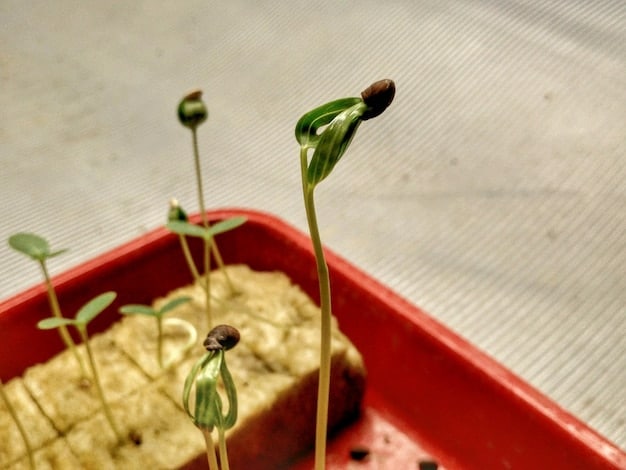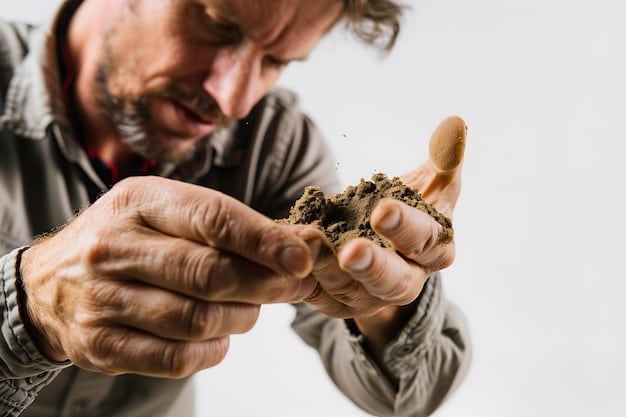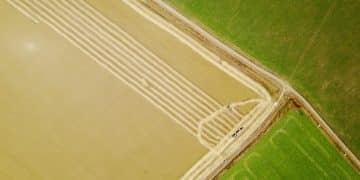No-Till Farming: Boost Soil Carbon by 15% in 2025

No-till farming enhances soil carbon sequestration by minimizing soil disturbance, preserving organic matter, and promoting healthier soil ecosystems, potentially increasing carbon levels by 15% by 2025 through optimized practices and supportive policies.
Ready to explore how **no-till farming can increase your soil carbon sequestration by 15% in 2025**? This method not only helps combat climate change but also enhances soil health and improves crop yields – a win-win for farmers and the environment.
Understanding No-Till Farming and Soil Carbon Sequestration
No-till farming is a conservation agriculture technique that avoids mechanical soil disturbance, such as plowing, tilling, or harrowing. This approach significantly impacts soil health and its capacity to sequester carbon.
Soil carbon sequestration refers to the process by which carbon dioxide from the atmosphere is captured and stored in the soil. Healthy soils are significant carbon sinks, helping to mitigate climate change.
Benefits of No-Till Farming
No-till farming offers numerous environmental and economic advantages. It reduces soil erosion, conserves water, and improves soil structure.
How No-Till Farming Enhances Carbon Sequestration
By minimizing soil disturbance, no-till farming preserves existing organic matter and allows for the accumulation of new carbon compounds. This leads to increased carbon sequestration.
- Reduced Soil Disturbance: Minimizes the release of stored carbon.
- Improved Soil Structure: Enhances water infiltration and retention.
- Increased Organic Matter: Boosts soil fertility and carbon storage.
- Enhanced Microbial Activity: Promotes decomposition and carbon cycling.
Implementing no-till practices can significantly improve soil carbon sequestration rates. Farmers who adopt these methods often see notable increases in soil carbon levels over time.
Implementing No-Till Farming Practices
Transitioning to no-till farming requires careful planning and adjustments to existing farming practices. However, the long-term benefits are well worth the initial effort.
Successful implementation involves selecting appropriate equipment, managing crop residues, and adopting effective weed control strategies.

Equipment for No-Till Farming
Specialized equipment, such as no-till planters and drills, is necessary to sow seeds directly into undisturbed soil. These tools ensure proper seed placement and germination.
Managing Crop Residues
Leaving crop residues on the soil surface is crucial for no-till farming. These residues protect the soil, suppress weeds, and provide a source of organic matter.
- Residue Cover: Protects against erosion and moisture loss.
- Weed Suppression: Reduces the need for herbicides.
- Nutrient Cycling: Releases nutrients back into the soil as it decomposes.
Effective residue management involves distributing residues evenly across the field and ensuring they do not interfere with planting.
Optimizing Soil Health for Carbon Sequestration
Healthy soils are essential for maximizing carbon sequestration. Optimizing soil health through no-till practices and other sustainable agriculture techniques can significantly enhance carbon storage.
Soil health encompasses various physical, chemical, and biological properties that contribute to its overall functionality and productivity.
Soil Testing and Analysis
Regular soil testing provides valuable information about nutrient levels, pH, and organic matter content. This data helps farmers make informed decisions about soil management.
Cover Cropping
Planting cover crops between cash crops is an excellent way to improve soil health. Cover crops add organic matter, suppress weeds, and prevent soil erosion.
- Increased Organic Matter: Boosts soil fertility and carbon sequestration.
- Weed Suppression: Reduces herbicide use.
- Erosion Control: Protects soil from wind and water erosion.
Selecting the right cover crop species is crucial for achieving specific soil health goals. Common cover crops include legumes, grasses, and brassicas.

The Role of Soil Microbes in Carbon Cycling
Soil microbes play a vital role in carbon cycling, influencing the decomposition of organic matter and the release of nutrients. Understanding these microbial processes is crucial for maximizing carbon sequestration.
These microorganisms include bacteria, fungi, protozoa, and nematodes, each contributing to different aspects of soil health and carbon dynamics.
Microbial Decomposition
Microbes break down organic matter, releasing carbon dioxide and nutrients. The balance between decomposition and carbon storage is critical for soil carbon sequestration.
Mycorrhizal Fungi
Mycorrhizal fungi form symbiotic relationships with plant roots, enhancing nutrient uptake and carbon allocation. These fungi can significantly increase carbon storage in the soil.
- Enhanced Nutrient Uptake: Improves plant growth and carbon sequestration.
- Increased Carbon Allocation: Transfers carbon from plants to the soil.
Promoting microbial diversity and activity through no-till practices and cover cropping can enhance carbon cycling and sequestration.
Measuring and Monitoring Soil Carbon
Accurately measuring and monitoring soil carbon levels is essential for tracking progress and evaluating the effectiveness of no-till farming practices. Various methods are available for assessing soil carbon stocks.
These methods range from traditional laboratory analyses to advanced remote sensing techniques, each with its own advantages and limitations.
Laboratory Analysis
Laboratory analysis involves collecting soil samples and measuring their carbon content using specialized equipment. This method provides accurate and detailed information about soil carbon levels.
Remote Sensing Techniques
Remote sensing techniques use satellite imagery and aerial photography to estimate soil carbon levels over large areas. These methods offer a cost-effective way to monitor soil carbon changes.
- Satellite Imagery: Provides broad-scale carbon monitoring.
- Aerial Photography: Offers detailed carbon assessment.
Combining laboratory analysis with remote sensing techniques can provide a comprehensive assessment of soil carbon sequestration.
Policy and Economic Incentives for No-Till Farming
Government policies and economic incentives play a crucial role in promoting the adoption of no-till farming practices. These incentives can help offset the initial costs and risks associated with transitioning to no-till.
Supportive policies can encourage farmers to adopt sustainable agriculture practices and contribute to climate change mitigation.
Government Subsidies
Government subsidies can provide financial assistance to farmers who implement no-till farming practices. These subsidies can help cover the costs of equipment, training, and technical assistance.
Carbon Credits
Carbon credits offer an economic incentive for farmers to sequester carbon in their soils. Farmers can sell carbon credits to companies and organizations seeking to offset their carbon emissions.
- Financial Incentives: Rewards carbon sequestration efforts.
- Market Opportunities: Creates a market for soil carbon.
Policy and economic incentives can accelerate the adoption of no-till farming and enhance soil carbon sequestration on a large scale.
| Key Point | Brief Description |
|---|---|
| 🌱 No-Till Basics | Minimizes soil disturbance, enhancing carbon storage. |
| 🚜 Equipment Needs | Specialized planters and drills for no-till sowing. |
| 🌿 Cover Crops | Improves soil health and carbon sequestration. |
| 💰 Policy Support | Subsidies and carbon credits drive adoption. |
Frequently Asked Questions about No-Till Farming
▼
No-till farming is a conservation practice where crops are planted directly into undisturbed soil. This reduces erosion, conserves water, and enhances soil health by maintaining organic matter.
▼
Specialized no-till planters and drills are required to sow seeds directly into the soil without prior cultivation. These tools ensure proper seed placement and germination in undisturbed conditions.
▼
By minimizing soil disturbance, no-till farming preserves organic matter and allows for the accumulation of new carbon compounds. This promotes healthier soil ecosystems and increased carbon storage.
▼
No-till farming reduces input costs, such as fuel and labor, while also improving crop yields in the long term. Additionally, carbon credits can provide an extra income stream for farmers.
▼
Cover crops are planted between cash crops to improve soil health, suppress weeds, and prevent erosion. They also add organic matter, which enhances carbon sequestration and fertility.
Conclusion
Adopting no-till farming practices offers a pathway to increasing soil carbon sequestration by 15% by 2025. By understanding and implementing the techniques discussed—from using specialized equipment to optimizing soil health and leveraging policy incentives—farmers can significantly contribute to mitigating climate change while enhancing the productivity and sustainability of their operations.





